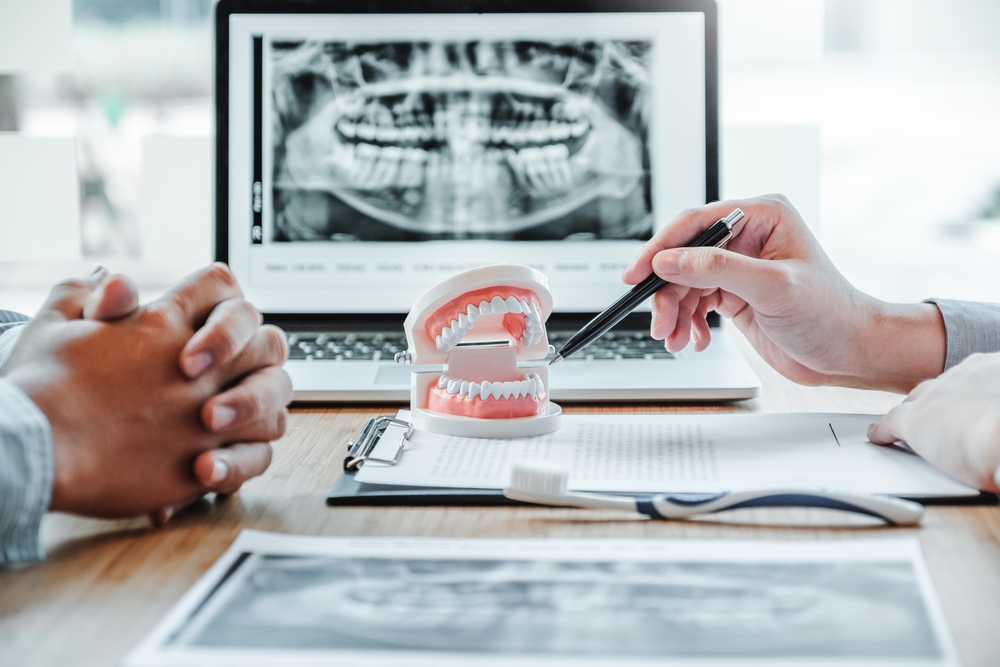
X-Ray

An X-ray is a diagnostic tool used by a dentist to capture detailed images of your teeth, roots, jaw placement, and facial bones. This technology helps detect problems that are not visible during a standard dental examination, such as cavities, infections, and periodontal disease. By providing a comprehensive view, X-rays enable the dentist to diagnose and treat dental issues accurately and efficiently. They are crucial for identifying early signs of tooth decay, assessing the health of tooth roots, and monitoring the development of teeth in children and teenagers. Modern digital X-rays reduce radiation exposure and offer quicker results compared to traditional films, enhancing the overall dental care experience.
During a dental visit, the dentist will determine if X-rays are necessary based on your oral health history and symptoms. The process involves placing a small sensor in your mouth to capture images, which are then reviewed to identify any underlying issues and develop an appropriate treatment plan. X-rays play a vital role in preventative dentistry, helping catch issues early before they become serious problems. They are essential for regular check-ups, treatment planning, progress monitoring, and post-treatment evaluation. By incorporating X-rays into routine dental visits, the dentist ensures thorough and accurate care, leading to more effective treatments and better overall dental health.
Request Appointment
FAQs
Can I refuse dental x-rays?
You have complete autonomy over your dental care decisions, including whether to receive x-rays. When patients decline x-rays at PhD Orthodontics, we explain how our 3D CBCT and intraoral scanning help provide evidence-based care. While we can offer basic consultations without x-rays, orthodontic treatments require detailed internal views to ensure safe, effective care, especially for complex craniofacial cases.
Are dental x-rays safe?
The advanced digital imaging technology at PhD Orthodontics reduces radiation exposure by up to 80% compared to traditional x-ray machines. You’ll receive less radiation from our complete orthodontic imaging series than from a single cross-country flight. We provide protective lead aprons and thyroid collars as additional safety measures during all procedures.
How many dental x-rays are safe in a month?
At PhD Orthodontics, we follow the ALARA principle – “As Low As Reasonably Achievable.” We recommend comprehensive 3D CBCT scans during initial consultation and progress evaluations, with specific x-rays only as needed for treatment monitoring. Dr. Xuanyu Lu’s evidence-based approach maintains detailed imaging records and coordinates with other providers to prevent unnecessary duplication.
How much are dental x-rays?
We believe in transparent pricing for all our orthodontic services, including advanced imaging. Costs vary depending on the type and complexity of imaging needed for your specific treatment plan. We work directly with your insurance provider to maximize coverage, as most plans include diagnostic imaging in their orthodontic benefits. Our team provides detailed cost estimates and flexible payment options during your consultation.
Can you get dental x-rays while pregnant?
We reserve orthodontic x-rays for urgent treatment needs during pregnancy, using double lead aprons and precise beam targeting for maximum protection. Our evidence-based approach includes communication with your prenatal care team. We can coordinate timing for comprehensive 3D imaging after delivery to ensure optimal treatment planning.
Do dental x-rays show cancer?
Our advanced 3D CBCT and digital systems can reveal oral and craniofacial abnormalities, including potential cancer signs. Dr. Xuanyu Lu conducts thorough screenings using his craniofacial research background. If we identify concerning patterns, our multidisciplinary approach includes established relationships with oral pathologists and oncologists for prompt, specialized evaluation.

